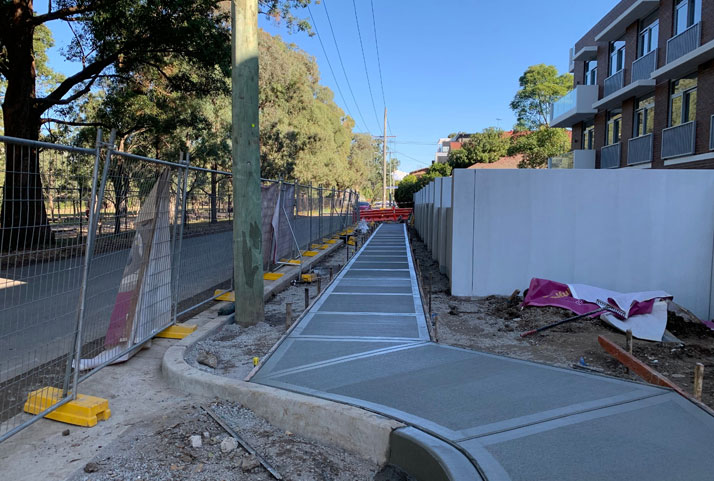Concrete is renowned for its strength and durability, making it a popular choice for driveways, pathways, patios, and slabs across Sydney. However, even the most expertly laid concrete can develop cracks over time. Understanding why concrete cracks and how to prevent it is crucial for homeowners looking to maintain the longevity and appearance of their concrete surfaces.
Understanding Concrete Cracks
Cracks in concrete are common and can occur due to various factors. While some cracks are superficial and merely affect the appearance, others can indicate underlying structural issues. It’s essential to distinguish between the two to determine the appropriate course of action.
Common Causes of Concrete Cracks
1. Shrinkage During Curing
As concrete cures, it undergoes a process called drying shrinkage. This occurs when water evaporates from the concrete mix, causing it to contract. If the concrete dries too quickly or lacks proper control joints, shrinkage cracks can develop. These are typically hairline cracks but can become more pronounced if not addressed.
2. Thermal Expansion and Contraction
Sydney’s climate can be quite variable, with hot summers and cool winters. Concrete expands in high temperatures and contracts when it cools. Without adequate expansion joints, this movement can lead to cracks, especially in larger slabs.
3. Subgrade Settlement
The ground beneath the concrete, known as the subgrade, must be properly prepared and compacted. If the subgrade settles unevenly after the concrete has been poured, it can cause the slab to crack. This is particularly common in areas with clay soils, which are prevalent in parts of Sydney.
4. Overloading
Concrete is designed to withstand specific loads. Exceeding these limits, such as parking heavy vehicles on a driveway not designed for such weight, can cause stress cracks. It’s essential to ensure that the concrete’s thickness and reinforcement match its intended use.
5. Improper Joint Placement
Control joints are deliberate cuts made in the concrete to guide where cracks should occur. If these joints are improperly placed or too far apart, random cracking can occur. Proper joint placement is a critical aspect of concrete installation.
Types of Concrete Cracks
Understanding the different types of cracks can help in identifying their causes and determining the appropriate remedial measures.
1. Hairline Cracks
These are thin cracks that appear on the surface and are often due to shrinkage during curing. While they may not pose structural issues, they can allow moisture ingress, leading to further problems over time.
2. Settlement Cracks
These occur when the subgrade settles unevenly, causing the concrete to crack. Settlement cracks are usually wider and may indicate issues with the ground preparation.
3. Structural Cracks
These are significant cracks that can compromise the integrity of the structure. They may be caused by overloading, poor construction practices, or significant ground movement. Structural cracks often require professional assessment and repair.
Preventing Concrete Cracks
While it’s challenging to eliminate all cracking, several measures can significantly reduce the risk:
1. Proper Subgrade Preparation
Ensuring the ground is well-compacted and stable before pouring concrete is crucial. This provides a solid foundation and minimises the risk of settlement cracks.
2. Adequate Curing
Curing is the process of maintaining adequate moisture in the concrete after placement. Proper curing prevents rapid drying, reducing shrinkage cracks. Methods include water curing, using curing compounds, or covering the concrete with wet burlap.
3. Correct Joint Placement
Strategically placing control joints allows for controlled cracking. These joints should be placed at appropriate intervals and depths, depending on the slab’s thickness and size.
4. Using Quality Materials
High-quality concrete mixes with appropriate water-cement ratios and admixtures can enhance durability and reduce the likelihood of cracking.
5. Professional Installation
Engaging experienced professionals ensures that best practices are followed during installation. At Inspire Concrete, our team adheres to industry standards, ensuring your concrete surfaces are built to last.
Repairing Concrete Cracks
If cracks do occur, timely repair is essential to prevent further deterioration. Depending on the crack’s size and cause, repair methods may include:
- Epoxy Injections: Used for structural cracks to restore strength.
- Sealants: Applied to hairline cracks to prevent moisture ingress.
- Overlaying: Adding a new layer of concrete or resurfacing to restore appearance and functionality.
It’s advisable to consult with professionals to determine the most suitable repair method.
Why Choose Inspire Concrete?
At Inspire Concrete, we understand the challenges posed by Sydney’s unique climate and soil conditions. Our commitment to quality, combined with years of experience, ensures that your concrete surfaces are both functional and aesthetically pleasing.
We offer a range of services, including:
- Concrete Driveways: Durable and stylish solutions tailored to your needs.
- Pathways and Patios: Enhancing outdoor spaces with quality craftsmanship.
- Shed and Granny Flat Slabs: Providing solid foundations for your structures.
Our team is dedicated to delivering projects that stand the test of time. With a focus on customer satisfaction and adherence to best practices, we ensure that your investment is protected.
Don’t live with cracked concrete
While concrete cracking is a common issue, understanding its causes and implementing preventive measures can significantly reduce its occurrence. By choosing experienced professionals like Inspire Concrete, you ensure that your concrete surfaces are built to withstand the test of time.If you’re planning a concrete project or need advice on maintaining your existing surfaces, contact us today. Our team is here to assist you every step of the way.

